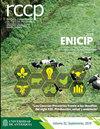兔体内和体外胚胎的非同步性
IF 0.5
4区 农林科学
Q4 AGRICULTURE, DAIRY & ANIMAL SCIENCE
引用次数: 0
摘要
背景:在体外和体内条件下发育的胚胎的比较特征对于设计胚胎移植程序以满足胚胎受体同步要求尤为重要。目的:探讨体外培养胚胎与体内胚胎发育的不同步程度。方法:选取非哺乳期多胎母犬55只。在性交后48小时,胚胎分为16个细胞或早期桑葚胚。将胚胎培养30 h和32 h,并与72 hpc的体内胚胎进行比较。72hpc的离体和体内胚胎分为早期胚和致密胚。采用贝叶斯统计。估计体内和体外胚胎差异及体内和体外胚胎差异大于零的实际概率(P)。结果:非同步+6 h时,体内胚的桑葚胚压实率高于体外胚(73.5%和32.8%,P=1.00);但与+8 h异步时压实的模子百分比相似。结论:体外胚胎比体内胚胎发育延迟8小时。本文章由计算机程序翻译,如有差异,请以英文原文为准。
Asynchrony between in vivo and in vitro rabbit embryos
Background: The comparative features of embryos that develop under in vitro and in vivo conditions are particularly important in designing embryo transfer procedures that fulfil embryorecipient synchronization requirements. Objective: To determine the degree of asynchrony in embryo development between cultured and in vivo embryos. Methods: A total of 55 non-lactating multiparous females were used. Embryos were classified as 16-cells or early morulae at 48 hours post-coitum (hpc). Embryos were cultured during 30 or 32 h and embryo development was compared with in vivo embryos of 72 hpc. In vitro and in vivo embryos at 72 hpc were classified as early or compacted morulae. Bayesian statistics was used. Difference between in vivo and in vitro embryos and the actual probability of the difference between the in vivo and in vitro embryo higher than zero (P) was estimated. Results: The percentage of compacted morulae was higher in in vivo embryos than in in vitro embryos with +6 h of asynchrony (73.5 and 32.8%, P=1.00). But the percentage of compacted morulae was similar with +8 h asynchrony. Conclusions: In vitro embryos delay their development by + 8 hours compared to in vivo embryos.
求助全文
通过发布文献求助,成功后即可免费获取论文全文。
去求助
来源期刊

Revista Colombiana De Ciencias Pecuarias
AGRICULTURE, DAIRY & ANIMAL SCIENCE-
CiteScore
0.80
自引率
0.00%
发文量
18
审稿时长
6-12 weeks
期刊介绍:
The editors of Revista Colombiana de Ciencias Pecuarias (RCCP) welcome the submission of original manuscripts on experimental and clinical studies associated with the broad areas of animal sciences and veterinary medicine as they interface with biochemistry, molecular biology, physiology, pharmacology, toxicology, pathology, microbiology, parasitology, immunology and epidemiology. The scope of the journal includes studies of basic and applied research in animal management and production, feeding and nutrition, reproduction, breeding, genetics, animal welfare and behavior; as well as animal production focussed from biotechnology, soil science, agrostology, silvopastoral systems, livestock economics and the environment.
The criteria for acceptance of papers submitted for publication are originality, quality and clarity of the content. Each contribution must be based on original, unpublished research that has not been simultaneously submitted to other journals. All papers will be peer reviewed. All authors bear responsibility for ensuring the integrity and quality of their reported research. It is the author''s responsibility to secure permission to use figures or tables that have been published elsewhere.
Contributions may be classified as original research, review, rapid communication, clinical case studies or methodological articles, as well as news/commentaries or letters to the editor. Most review articles are invited by the editor. Authors interested in submitting a review article should contact the corresponding editor. Rapid publication of original manuscripts is a goal of the journal. Manuscripts must be written in English. Each manuscript is considered for publication with the understanding that it has not been simultaneously submitted to any other journal. Upon acceptance for publication, papers are subject to editorial review and revision.
 求助内容:
求助内容: 应助结果提醒方式:
应助结果提醒方式:


